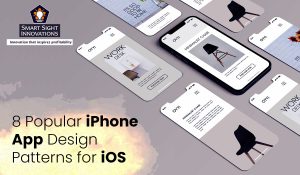 Synopsis: Expert iOS developers with advanced skills who have done many iOS projects will surely know that choosing a suitable design pattern is of utmost importance. Incorporating the right features helps a project to run smoothly and become more readable, flexible and reusable. Knowing about the most popular iOS design patterns helps. With the right knowledge about iOS design patterns, you can see what is available and what is common in iPhone app design patterns for iOS.
Synopsis: Expert iOS developers with advanced skills who have done many iOS projects will surely know that choosing a suitable design pattern is of utmost importance. Incorporating the right features helps a project to run smoothly and become more readable, flexible and reusable. Knowing about the most popular iOS design patterns helps. With the right knowledge about iOS design patterns, you can see what is available and what is common in iPhone app design patterns for iOS.
Serving as a suitable template, iPhone app design patterns help solve specific problems. And, they also help reduce potential errors that may appear during testing and make it more productive. These design patterns help in writing simple clean code which accelerates the development process to deliver high-quality results.
The main iOS design patterns are divided into 3 groups:
- Creative
- Behavior
- Structural
-
Singleton (Creative group)
Let’s say you only need one object copy. This can be a real object such as a printer, server, or something that doesn’t have many copies. IOS devices have a UserDefaults object that can be accessed via a standard property. No one could make a new copy of the object.
This design method is needed to duplicate only one piece from the entire pattern. It describes all the objects on the screen and repeats a certain object one or more times. Singleton design is best when you need to manage resources.
Features of the Singleton design pattern include:
- Only one instance that gives it a global access
- Tracking its only instance and ensuring that no other instance can be created
- Suitable for providing access to a global resource for a single object.
- Using lazy loading to create a single instance the first time it is needed.
-
Builder (Creative group)
This pattern allows you to develop simple objects from complex objects by moving step by step. Also, you can create multiple object views using the same code in the Builder design pattern.
A complex object requires the initialization of common objects and many fields. Here, the code is also hidden inside the constructor with a lot of parameters. So to solve this, the Builder design pattern separates the construction of the object from its class.
It separates configuration from object creation. The calling object contains the configuration data and transfers it to the Builder object which is responsible for creating the object.
Suppose, there is a restaurant that needs to build an app to order sandwiches. To avoid asking visitors about each ingredient, there is a need to create a default value in the builder class. If some customers do not want onion, the default value in the Builder class is ‘true’.
Features of the Builder design pattern include
- Avoid using a telescopic constructor with multiple parameters
- Creating different views of a specific object
- Composing complex objects
-
Decorator (Structural group)
The Decorator pattern allows you to wrap new functionality in easy wrappers and dynamically binds them to an object. Hence this design pattern is also known as the Wrapper design pattern.
In a Decorator pattern, you need to implement the target object under another wrapper that activates the target object’s behavior and includes its attributes in the final result.
This design uses (1) extension and (2) delegation.
When extensions are needed, the Decorator design pattern is used. For example, Windows operating systems require optional features such as a title bar, status bar and scrollbar.
In delegation, the Decorator adds the essential behaviors and responsibilities to the object without modifying its code. For example, it is useful when using third-party libraries that do not have access to the source code. Features of the Decorator include:
- It assigns new responsibilities to an object.
- Decorators are ornaments that are placed on pine or fir trees to make them look festive.
-
Observer (Behavioral group)
Observer objects help notify others about their status change. One object usually signals a change in another as in Push notifications. Some objects notice changes in other objects, especially when the objects change frequently.
In case of an internal dependency between different objects, action needs to be performed to change the state of that object. At times, objects need to update other objects without knowing their identity in the first place.
Take the Twitter app example. After following someone on Twitter, it automatically adds you to its following list. Whenever a new tweet is published, it will be displayed. Here, the Observer is your Twitter account.
The Observer is dependent on other objects and uses publish and subscribe models. It uses 3 features:
- Subject
- Observer
- Customer
-
Memento (Behavior group)
Memento aims to save objects like Collections, UserDefaults, and NSCoding protocols using CoreData. The confidentiality of the data is maintained.
The Memento method externalizes and captures the internal state of an object so that it can be restored later. It is used whenever items need to be restored to their previous states.
For example, this technique is used by do-it-yourself mechanics who repair their car tires. The tires on both sides are removed, revealing the insides. Features of the Memento are:
- Only one side is isolated, while the other is a reminder of how the components are connected.
- After one side is finished, the other side comes apart.
- Memento is the first part when the other side falls apart.
-
Facade (Structural group)
The Facade is an iOS app design pattern that provides a simplified interface for complex systems. Instead of showing multiple methods with different interfaces, a class encapsulating other objects gives the user a simplified interface.
It is a pattern that is equipped with a simple interface such as a system of classes, a framework, and a library (masking a complex system of classes).
For example, consider the computer startup to know the Facade design pattern. The computer starts up depending on hardware such as memory, hard drive, and motherboard. To reduce the complexity here, a computer will display all the functionalities using a single interface.
The use of a Facade is ideal when creating a complex subsystem. The Facade design pattern does the same by hiding the complexities of the system by allowing the client to have easy access to the system. Features of the mask include:
- A simple and unified interface
- Decomposing a subsystem into different layers
-
Adapter (Structural group)
It allows classes with incompatible interfaces to bind together. Apple implements this template using protocols. This pattern is used when you need to integrate a component that contains code that cannot be modified. It is useful when dealing with an inherited class.
You can use an Adapter when you need a third-party class but the interface doesn’t match the exact application’s code. In the absence of specific functionality and limited extensibility, you can use Adapter using existing subclasses.
Take the example of Birds with fly and sound methods. Suppose you run low on Myna objects and want to replace them with just birds. All birds have some similar talents but their interface is different and cannot be used directly. Therefore, the Adapter pattern steps in. While Bird would be an adapter Myna could be a customer. Features of the Adapter include
- It allows objects with incompatible interfaces to help work together.
- It helps to change the interface of an object and expect them to adapt to a different object.
-
Template (Behavior group)
The Template pattern is considered an algorithmic method, delegating responsibilities to subsystem steps. It allows subclasses to redefine the steps of an algorithm without affecting the overall structure. The algorithm is divided into several parts, each expressed in several ways using a template approach.
For example, creating software to shoot and save images requires the use of an iPhone or iPad and a photo gallery. Features of the Template design include:
- Using a specific algorithm to implement the PermissionService base class.
- Creating two subclasses named CameraPermissionService.
Finally
Design patterns help to simplify code writing for developers in IOS app development services and provide an efficient work process for programmers.
There are over 20 app design patterns. The choice can be confusing. If looking for the best iOS app design, consult an experienced app development team.
One of the leading iOS application development services can help you build fully functional iOS apps using the latest iOS design patterns.













